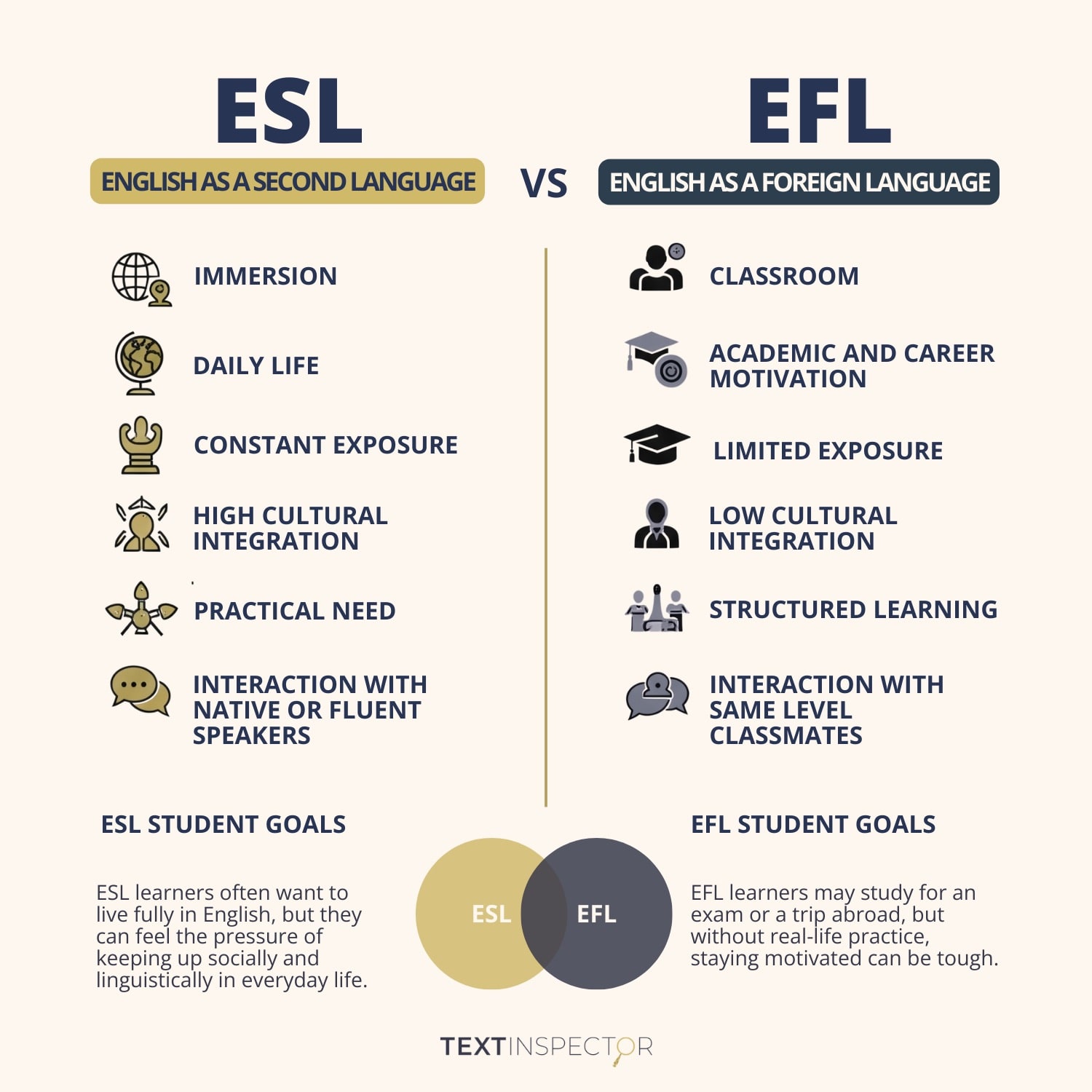
English is taught and learned all over the world, but the context in which it’s learned can significantly shape a student’s experience.
One common distinction in the language teaching world is between English as a Second Language (ESL) and English as a Foreign Language (EFL); terms that sound similar but describe very different learning environments.
Basically, the main difference between ESL and EFL is in the location and circumstances around the learning of the English language.
While ESL implies learning English in an English-speaking country, EFL involves learning English in a non-English-speaking country. So the key distinction lies in the learning environment.
Although the ultimate goal for most learners is English proficiency, the path toward that goal can vary wildly depending on where and how students are learning.
In this article, we’ll explore the fundamental differences between ESL and EFL, define both terms, and discuss why understanding these distinctions matters for both educators and learners.
Key Differences Between ESL and EFL

As we mentioned, ESL stands for English as a Second Language and refers to learning English in a country where English is the dominant or official language. EFL, or English as a Foreign Language, refers to learning English in a country where it is not commonly spoken.
Though they may seem interchangeable, ESL and EFL present distinct challenges, environments, and goals. These differences shape the teaching strategies used and the learning outcomes achieved.
Here’s a breakdown of how each context influences different learning aspects:
| Feature / Aspect | English as a Second Language (ESL) | English as a Foreign Language (EFL) |
| Learning Environment | Immersion in an English-speaking country; high daily exposure. | Limited exposure outside the classroom; non-English-speaking country. |
| Learner Motivation | Integration into society, work, education, daily life. | Academic tests, global communication, career or travel opportunities. |
| Access to Practice | Constant real-life communication in English. | Mostly limited to classroom and digital resources. |
| Cultural Integration | High: learners often adopt local customs and accents. | Low: exposure to English-speaking culture is mostly via foreign media or English lessons. |
| Instructional Focus | Practical communication, survival English, functional language use. | Structured grammar, vocabulary acquisition, formal exam preparation. |
| Teacher’s Role | Facilitator of real-world interactions and cultural bridge. | Knowledge provider, structured instruction leader. |
| Peer Interaction | Frequent with native speakers or fluent non-natives. | Mostly with classmates who share a similar proficiency level. |
Why These Differences Matter: Implications for Education
These differences aren’t just technical labels—they directly impact the way language is taught and learned. Whether you’re a teacher planning a lesson or a student choosing how to study, knowing the context can change everything.
For Educators:
- You’ll need to adapt lesson content based on real-world exposure levels.
- ESL classes often require more support with social and cultural integration.
- EFL teaching can rely more heavily on structured grammar and vocabulary.
- Classroom materials and activities should match the students’ interaction opportunities.
- Testing and assessment methods should reflect each learner’s reality.
For Learners:
- ESL learners may feel pressure to “keep up” socially and linguistically in daily life.
- EFL learners might struggle to stay motivated due to lack of real-life practice.
- Goals can differ: ESL learners often aim to live in English; EFL learners may study for an exam or future travel.
- Understanding your context helps you choose the right materials and strategies.
- Expectations should be adjusted to match learning exposure—fluency takes different paths in each case.
Frequently Asked Questions about EFL and ESL
Can an EFL learner become fluent just like an ESL learner?
Yes, EFL learners can become just as fluent as ESL learners, but it usually requires more conscious effort. Without daily immersion, learners need to supplement with practice via media, conversation partners, travel, and consistent study. Fluency is about input, output, and motivation—not just geography.
What certifications do I need to teach ESL or EFL?
Most international teaching jobs require certifications like CELTA, TESOL, or TEFL. However, for ESL positions (especially in public schools), a teaching license and sometimes a degree in education or linguistics are also required. Requirements vary by country and context.
Is one method (ESL or EFL) “better” for learning English?
No, neither is inherently “better.” Each has its advantages and limitations. ESL offers real-life exposure and practical learning, while EFL can provide more structured, academically focused training. The best method depends on the learner’s goals, needs, and environment.
Are ESL and EFL textbooks different?
Yes, they usually are. ESL textbooks tend to focus more on survival English, conversation, and integration into an English-speaking society. EFL textbooks are often more grammar-heavy and exam-oriented, with fewer references to everyday life in English-speaking countries.
How does the “second” or “foreign” distinction relate to my native language?
The terms don’t refer to your first language, but rather to the setting in which you’re learning English. Even if English is your third or fourth language, if you’re learning it in an English-speaking country, it’s ESL. On the other hand, if you’re learning in a non-English-speaking country, it’s EFL.
Conclusions
As English continues to grow as the global lingua franca, language education must stay flexible and adaptive to context. Whether learners are surrounded by English or only encounter it in the classroom, effective instruction begins with understanding their environment.
Recognizing the difference between ESL and EFL isn’t just an academic need: it’s essential for good teaching, successful learning, and accurate resource development.
Would you like to fine-tune your English teaching materials? Try Text Inspector to analyze text difficulty and ensure your content matches your learners’ needs. Accurate, data-driven resources make all the difference.
Share
Related Posts

How to Use Text Inspector to analyse Harry Potter and the Philosopher’s Stone
7 July, 2025
Understanding the complexity of a text is vital in English Language Teaching (ELT). Choosing materials […]
Read More ->
What is the Expected CEFR Level for the TOEFL Exam?
19 July, 2025
Helping students prepare for high-stakes exams like the TOEFL can be both exciting and overwhelming. […]
Read More ->
What is a Linguistic Register & Language Register? A quick way to improve your English
26 June, 2023
As speakers we tend to modify the way we speak depending on the context in which we find ourselves. Different environments require different registers.
For example, we do not communicate our anger towards a teacher in class the same way we would towards the referee in a football match.
Read More ->